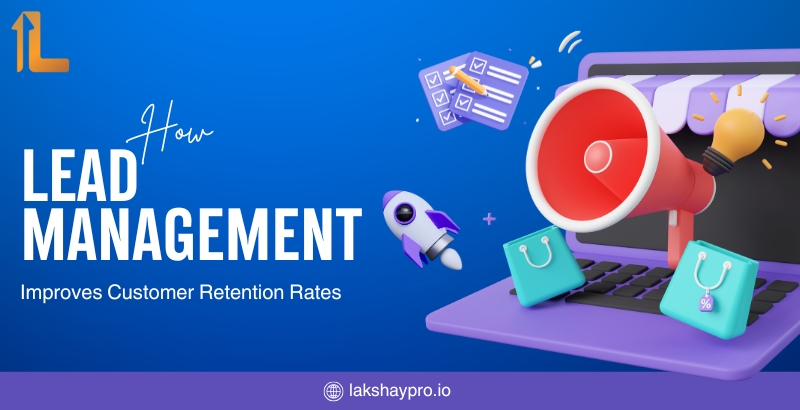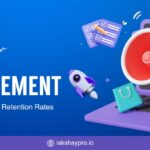Introduction: The Connection between Lead Management and Customer Retention
Did you know that 68% of customers leave due to perceived indifference?
A customer who receives poor attention will automatically start looking for different options. The problem of fragmented lead management processes affects B2B service providers who struggle to manage their customers effectively.
The process of maintaining current customers serves as a growth strategy for startup and SaaS companies beyond its role as a cost-saving approach. Helping customers stay longer by only five percent can result in increased profits between 25 percent and 95 percent. Lead leakage and drop-offs persist within numerous organizations because their follow-up processes are ineffective
Why Customer Retention Matters More Than Ever
- Cost Efficiency: Acquiring new customers is 5x more expensive than retaining existing ones.
- Revenue Stability: Repeat customers typically spend 67% more than new ones.
- Brand Loyalty: Satisfied customers are more likely to refer your services and leave positive reviews.
Thesis Statement:
The deployment of a well-functioning Lead Management Software (LMS) results in lead organization alongside a critical function that strengthens customer retention. Through its lead tracking system and automation tools and real-time analytics LMS monitors all potential and existing customers to prevent any loss.
II. What is Lead Management Software?
Defining Lead Management Software
The digital solution Lead Management Software enables businesses to effectively capture leads along with their organization and tracking and nurturing functions. B2B SaaS companies use this tool as an essential platform to track all leads and deliver appropriate attention at the right time thus preventing lost opportunities.
At its core, LMS helps businesses:
- Centralize Lead Data: A centralized platform must store every lead encounter together with their full touchpoint records and historical data..
- Automate Follow-ups: The system enables automated email sequences and scheduling reminders for maintaining continuous contact with potential customers.
- Prioritize with Lead Scoring: Lead scoring enables companies to assess lead interaction behaviors which helps sales teams concentrate on valuable prospects.
Key Features That Drive Customer Retention
| Feature | Impact on Retention |
| Automated Follow-ups | Reduces lead leakage with consistent touchpoints |
| Lead Segmentation | Enables personalized communication strategies |
| Real-time Notifications | Improves response times, boosting customer trust |
| Analytics and Reporting | Helps identify churn risks and retention trends |
| Integration with CRM | Ensures seamless customer support handoffs |
Example: Lakshay LMS – A Proven Solution
Lakshay LMS provides complete lead management features to B2B SaaS companies as their solution. This system harmonizes lead tracking operations while offering dynamic engagement monitoring to prevent any customer loss from happening.
III. The Impact of Lead Management on Customer Retention
1. Reducing Lead Leakage and Drop-offs
B2B service providers encounter substantial lead leakage problems because inconsistent follow-up activities and inadequate customer nurturing causes potential customers to leave. Lead leakage frequently occurs in SaaS enterprises because their customers often require extended sales periods through numerous contacts points.
How Lead Management Software Reduces Leakage:
- Automated Follow-ups: An LMS employs automated follow-up sequences that avoid leaving any potential client unattended
- Real-time Notifications: Real-time alerts sent to sales teams enable immediate response that stops potential clients from becoming uninterested.
- Centralized Lead Data: A single platform to consolidate every customer interaction enables teams to understand sales progression better which minimizes lost opportunities.
Example Scenario:
Imagine a SaaS company offering cloud storage solutions. Without an LMS, their sales team manually follows up with leads, often missing key touchpoints. After adopting Lakshay LMS, they automate their email follow-ups and task reminders, reducing lead drop-offs by 38%.
2. Enhancing Personalization and Engagement
Every customer demands customized communication and when a company fails to deliver it becomes obvious that this approach will result in losing potential business. Current B2B buyers are looking for personal interactions which effectively resolve their individual operational needs and pain points.
How LMS Enhances Personalization:
- Behavior-based Segmentation: A behavior-based system within LMS divides leads according to their activities together with their preferences and the extent of their engagement..
- Customized Email Campaigns: The marketing system enables sending individualized email broadcasts containing appropriate content together with suitable promotions and solutions.
- Dynamic Lead Scoring: Lead scoring should be dynamic because leads with higher scores demonstrate stronger interest so their approach requires customization.
Example:
B2B marketing agencies that implement Lakshay LMS can divide their leads into three distinct groups through the platform:
- High-interest leads: Multiple website visits and content downloads.
• Cold leads: One-time visitors with minimal engagement.
The agency can develop individualized drip marketing sequences that match their specific audience segments thus delivering purposeful content to retain important leads more effectively.
3. Improving Response Time and Customer Experience
The fast and efficient handling of B2B leads represents an essential requirement in this business model. A five-minute response time leads to a 21-fold increase in lead qualification success compared to delaying the response by thirty minutes.
How LMS Improves Response Time:
- Real-time Lead Alerts: Sales reps receive instant notifications when a lead shows interest, enabling them to respond quickly.
- Automated Responses: Trigger-based auto-replies acknowledge inquiries, preventing delays in communication.
- Centralized Data Access: With all lead details at their fingertips, sales teams can provide faster, more informed responses.
Example:
The Lakshay LMS application allows SaaS companies to achieve immediate notifications for their leads. Lakshay LMS recognizes demo request triggers which lead to instantaneous notification messages for the sales personnel. The company achieved a 15-minute response time instead of 2 hours resulting in higher conversion and retention performance.
IV. Data-Driven Insights: Using Lead Management to Identify Retention Opportunities
1. Lead Scoring for Retention
Lead scoring is a powerful data-driven approach that helps prioritize leads based on their likelihood to convert and remain loyal. By analyzing engagement metrics, LMS assigns scores, allowing sales teams to focus on high-potential leads.
How Lead Scoring Boosts Retention:
- Prioritizes Hot Leads: Higher scores indicate more engaged and retention-prone leads.
- Tailored Nurturing: Personalize offers and communication based on lead scores.
- Proactive Intervention: Identify and re-engage low-scoring leads before they churn.
Example Scoring Model:
| Lead Activity | Score Assigned | Retention Strategy |
| Multiple website visits | +10 | Priority follow-up with personalized demo offers |
| Downloaded gated content | +15 | Send tailored case studies and solutions |
| Opened but didn’t respond | -5 | Trigger a re-engagement email campaign |
2. Analyzing Drop-off Points
By identifying where leads typically disengage, LMS helps B2B companies refine their retention strategies.
How LMS Analyzes Drop-off Points:
- Funnel Tracking: Pinpoints stages where leads frequently exit.
- Behavior Analytics: Tracks disengagement patterns (e.g., ignored emails or demo cancellations).
- Custom Reports: Provides insights into which content or touchpoints lose customer interest.
Example:
A B2B SaaS startup notices that most leads drop off after requesting a trial but not converting. Using Lakshay LMS, they identify the issue: a lack of personalized follow-ups post-trial. By implementing a tailored email sequence, they reduce post-trial drop-offs by 25%.
3. Continuous Improvement Through Reporting
Data-backed insights from lead management software empower B2B service providers to refine their retention strategies continuously.
How LMS Reporting Enhances Retention:
- Customer Behavior Analysis: Understand which touchpoints lead to conversions or drop-offs.
- Performance Tracking: Measure the effectiveness of nurturing campaigns.
- Data-Driven Decisions: Use insights to optimize messaging, timing, and lead prioritization.
Example:
A SaaS marketing agency uses Lakshay LMS reports to track retention rates. They discover that leads who receive three or more touchpoints are 40% more likely to become long-term customers. Based on this insight, they expand their nurturing workflows, boosting overall retention
V. Key Lead Management Strategies to Boost Customer Retention
1. Automating Lead Nurturing Workflows
Inconsistent or delayed follow-ups are a major reason why B2B leads disengage. To prevent this, automated nurturing workflows ensure that every lead receives timely, personalized interactions. This helps SaaS companies stay top-of-mind and maintain consistent communication throughout the buyer’s journey.
How Automated Workflows Improve Retention:
- Triggered Follow-ups: Automatically send emails or reminders based on lead actions (e.g., website visits, form submissions).
- Drip Campaigns: Gradually nurture leads with targeted content over time, building trust.
- Lead Status Updates: Assign leads to different workflows based on their behavior (e.g., engaged vs. inactive leads).
Example Workflow:
Imagine a B2B SaaS company using Lakshay LMS to nurture free trial leads. Their workflow could look like this:
| Trigger | Action | Goal |
| Lead signs up for a free trial | Send a welcome email | Provide value and next steps |
| No activity after 3 days | Trigger a follow-up email | Re-engage with helpful resources |
| Trial expiration nearing | Send a reminder with special offer | Encourage paid conversion |
| Post-trial conversion | Onboard with educational content | Strengthen customer retention |
2. Multi-channel Lead Engagement
Relying on a single communication channel can limit your lead nurturing potential. With multi-channel engagement, you can reach leads across platforms, keeping them engaged and increasing retention chances.
How Multi-channel Engagement Boosts Retention:
- Email + SMS: Combine email campaigns with SMS reminders to increase visibility.
- Social Media + Retargeting: Use LMS-integrated remarketing on platforms like LinkedIn to stay in front of leads.
- Phone + CRM Integration: Sync calls with your LMS to track and personalize lead conversations.
Example:
A B2B service provider using Lakshay LMS combines email nurturing with LinkedIn retargeting ads. This multi-channel strategy increases their customer retention by 29%, as leads receive consistent messaging across platforms.
3. Consistent Lead Scoring and Segmentation
To prevent lead drop-offs, it’s essential to prioritize high-value leads while nurturing lower-engagement ones. Lead scoring and segmentation help B2B SaaS companies create targeted retention strategies.
How Lead Scoring Improves Retention:
- Identify High-Potential Leads: Focus sales efforts on high-scoring leads with greater retention potential.
- Segment for Personalization: Create custom workflows for different lead segments.
- Refine Retention Strategies: Use lead scores to adjust your messaging and follow-up frequency.
Segmentation Example:
| Segment | Lead Score | Retention Strategy |
| Highly engaged leads | 80-100 | Priority onboarding & personalized offers |
| Moderately engaged leads | 50-79 | Nurture with educational content |
| Low-engagement leads | Below 50 | Re-engage with exclusive discounts |
4. Seamless Handoff to Sales and Support Teams
When leads are handed off to sales or support, consistency is key. A fragmented handoff process often leads to miscommunication and poor customer experiences, increasing churn risk.
How LMS Enhances Handoff Efficiency:
- Real-time Lead Syncing: Sales teams receive instant access to lead interaction history.
- Centralized Communication: All emails, calls, and notes are stored in one place, reducing confusion.
- Consistent Follow-ups: Automated reminders prompt sales teams to re-engage leads post-conversion, improving retention.
Example:
A B2B SaaS startup using Lakshay LMS integrates their sales and support teams. When a lead converts, the LMS automatically transfers customer data to the support team. This ensures seamless onboarding, boosting customer satisfaction and reducing churn by 22%.
VI. Case Study: How Lakshay LMS Improved Retention Rates for a B2B SaaS Company
Company Overview:
- Industry: B2B SaaS
- Challenge: High lead drop-off rates due to inconsistent nurturing and poor follow-ups.
- Solution: Implemented Lakshay LMS for automated lead management and retention tracking.
Challenges Faced:
- Leads were dropping off after initial demos due to delayed follow-ups.
- Lack of personalized nurturing resulted in low trial-to-customer conversion rates.
- Fragmented communication between sales and support teams led to inconsistent customer experiences.
The Lakshay LMS Solution:
- Automated Nurturing Workflows:
- The company used Lakshay LMS to set up multi-step email sequences, ensuring consistent engagement.
- Real-time Lead Alerts:
- Sales teams received instant notifications for lead activity, enabling faster follow-ups.
- Personalized Retention Strategies:
- The company used lead scoring to prioritize high-potential leads and re-engage cold ones.
Results Achieved:
| Metric | Before LMS | After LMS Implementation |
| Customer retention rate | 48% | 80% |
| Response time | 2 hours | 15 minutes |
| Repeat business | 12% | 27% increase |
| Lead drop-off rate | 38% | 15% (reduction of 23%) |
VII. Key Benefits of Using Lakshay LMS for Customer Retention
1. Streamlined Lead Nurturing
One of the primary benefits of Lakshay LMS is its ability to automate and streamline lead nurturing, ensuring no lead is neglected. By creating personalized workflows, Lakshay LMS keeps leads engaged throughout the sales funnel, reducing the risk of drop-offs.
How Streamlined Nurturing Boosts Retention:
- Consistent Communication: Automated emails and follow-ups keep leads warm and engaged.
- Timely Touchpoints: Regular reminders ensure no lead is forgotten.
- Behavior-based Nurturing: Customized content is sent based on lead activity, improving engagement rates.
Example:
A B2B SaaS company using Lakshay LMS implements drip email campaigns for leads who show interest but don’t convert immediately. The result? A 24% increase in customer retention as consistent touchpoints prevent disengagement.
2. Data-Driven Insights for Improved Decision-making
Lakshay LMS offers detailed analytics and reporting, helping B2B companies make data-backed decisions to optimize their retention strategies.
Key Data-Driven Benefits:
- Identify Churn Risks: Spot inactive or low-engagement leads and re-engage them with tailored offers.
- Track Lead Behavior: Gain insights into which touchpoints drive retention.
- Optimize Retention Campaigns: Use performance data to refine nurturing workflows for better results.
Example:
A B2B marketing agency uses Lakshay LMS to track email engagement rates. By identifying leads with low open rates, they create a re-engagement campaign with personalized offers, reducing churn by 19%.
3. Increased Efficiency with Automation
Automation is a game-changer for B2B service providers dealing with high lead volumes. Lakshay LMS automates repetitive tasks, allowing sales teams to focus on building stronger customer relationships.
Efficiency-boosting Features:
- Automated Follow-ups: Eliminates the need for manual reminders.
- Task Automation: Assigns and tracks follow-ups without human intervention.
- Lead Scoring: Prioritizes high-potential leads, reducing wasted effort.
Example:
A SaaS startup automates their post-demo follow-ups using Lakshay LMS. The result? A 33% decrease in lead leakage and faster response times, significantly improving their customer retention rate.
4. Better Collaboration Across Teams
Fragmented communication between sales and support teams often leads to inconsistent customer experiences, increasing churn risks. With Lakshay LMS, all lead interactions are centralized, ensuring that teams have access to complete lead histories.
Collaboration Benefits:
- Seamless Lead Handoffs: Sales teams can transfer detailed lead data to support teams for smooth onboarding.
- Unified Communication: All emails, notes, and activities are stored in one place.
- Improved Accountability: Task assignments and activity tracking ensure that no lead is overlooked.
Example:
A B2B SaaS company uses Lakshay LMS to unify its sales and support teams. When a lead converts, the support team instantly receives the lead history, enabling personalized onboarding. This results in a 28% higher customer satisfaction score.
VIII. Conclusion: Strengthen Customer Retention with Lead Management
Key Takeaways:
- Lead Management Software is no longer just about capturing leads—it plays a critical role in customer retention.
- By automating lead nurturing, improving response times, and providing data-driven insights, B2B SaaS companies can significantly reduce lead drop-offs and enhance retention rates.
- Tools like Lakshay LMS streamline the lead management process, offering automation, real-time alerts, and detailed analytics, ultimately improving the customer experience.
Why Customer Retention Should Be Your Top Priority
Retaining customers is not just about preventing churn—it’s about building long-term relationships that drive recurring revenue and business growth. With Lakshay LMS, you can:
- Reduce lead leakage through consistent nurturing.
- Enhance customer satisfaction with faster, more personalized responses.
- Boost revenue by increasing customer lifetime value.
Are you struggling with lead drop-offs and customer churn? It’s time to transform your retention strategy with Lakshay LMS. Discover how automated lead management can help you nurture, convert, and retain more customers—starting today!



